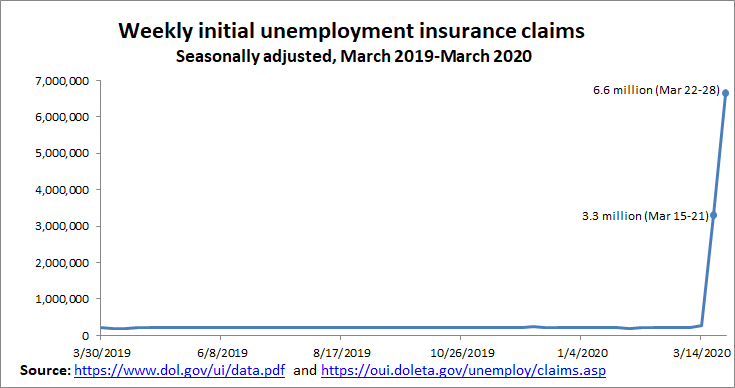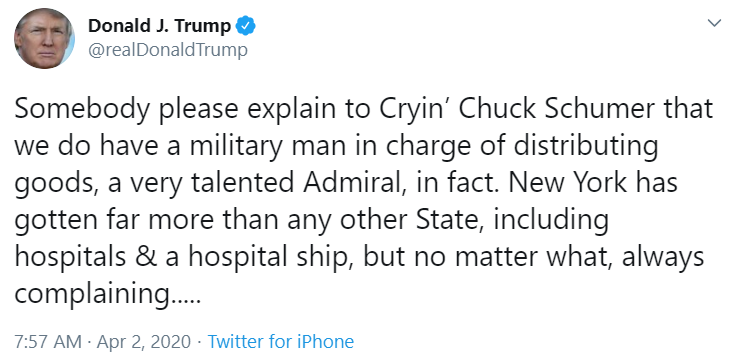Trump Labor Department accused of quietly ‘twisting the law’ to slash paid sick leave amid pandemic
April 2, 2020 By Jake Johnson, Common Dreams

“The Trump administration is robbing workers of the paid sick days and paid leave Congress passed into law for them. That is unconscionable.”
Two Democratic members of Congress on Thursday accused the Department of Labor of quietly “twisting the law” to limit the scope of already inadequate paid sick leave provisions contained in a coronavirus stimulus package that President Donald Trump signed into law last month.
Over the weekend, the Labor Department—headed by former corporate lawyer Eugene Scalia—published policy guidance on the Families First Coronavirus Response Act (FFCRA) that Sen. Patty Murray (D-Wash.) and Rep. Rosa DeLauro (D-Conn.) said creates several “gratuitous loopholes” allowing corporations to limit the number of employees eligible for paid leave.
Defend democracy. Click to invest in courageous progressive journalism today.
“This simply can’t stand. This guidance needs to be rewritten so workers get the leave they are guaranteed under the law.”
—Sen. Patty Murray
“The Trump administration is twisting the law to allow employers to shirk their responsibility and is significantly narrowing which workers are eligible for paid leave,” Murray said in a statement. “This simply can’t stand. This guidance needs to be rewritten so workers get the leave they are guaranteed under the law.”
The FFCRA, which Trump signed into law on March 18, provides two weeks of paid sick leave to eligible workers who fall ill and 12 weeks of leave to workers caring for children whose schools have closed due to the COVID-19 outbreak. The bill excludes workers at companies with more than 500 employees.
In a detailed letter (pdf) to Scalia on Wednesday, Murray and DeLauro said the Labor Department’s guidance blatantly “contradict[s] the plain language of the FFCRA and violate congressional intent.”
One example Murray and DeLauro highlighted is the Labor Department’s definition of “unable to work.”
“You are unable to work if your employer has work for you and one of the COVID-19 qualifying reasons set forth in the FFCRA prevents you from being able to perform that work, either under normal circumstances at your normal worksite or by means of telework,” the Labor Department wrote in its guidance.
Murray and DeLauro said that definition would “allow all employers to evade the requirements of the Act at any point during this pandemic by informing employees that it does not have work for them to perform at the moment—thereby fully depriving them of a day, a week, or 12 weeks of paid leave.”
“Nothing in the text of the FFCRA indicates the employer must have work for an employee to perform on any particular day for that employee to be able to qualify for paid leave on that day—nor does it give employers the authority to refuse their employees their statutory right to paid leave by not assigning them work, furloughing them, or closing a particular worksite,” Murray and DeLauro wrote in their letter.
In a press release, Murray and DeLauro summarized their concerns with the Labor Department guidance, warning that it would:
Require certification in order for workers to qualify for paid leave. DOL states that employers can require certification for employees to qualify for paid leave, even though the FFCRA does not require for any such certification from employees.
Restrict what qualifies as being “unable to work.” DOL states that employees only qualify for paid sick or family leave if they are unable to work and their employer has work for them, allowing employers to cut off employees’ rights to paid sick or family leave by claiming they have nothing for the employee to do. This guidance is in direct contradiction with the FFCRA, which does not allow employers to use those tactics to prevent employees from receiving paid leave.
Restrict worker’s ability to take leave intermittently. DOL states that an employee may only take their leave intermittently “if your employer allows it.” This conclusion is found nowhere in the text and gives the employer, rather than the employee who has the need for leave, the ability to decide how to use the employee’s leave.
Exempt employees from paid leave. FFCRA exempts narrowly defined “health care providers” from the paid leave provisions due to the nature of the current crisis. But without authority, DOL redefined a “health care provider” to include nearly any employee who happens to work for an employer who also employs a health care provider, works at any type of quasi-medical facility, works as an employee contracted for non-healthcare services in a facility that houses a health care provider, or merely works in the medical supply chain.
Not guaranteeing paid leave during a “shelter in place” order. DOL does not clarify that a government directive to stay at home qualifies for paid leave. In fact, DOL even indicates that employees lose their right to paid leave if their employer closes the employee’s worksite in the event of a government directive. This clearly defies the FFCRA which grants paid leave to employees who are subject to quarantine or isolation orders from government officials.
“In the middle of the COVID-19 pandemic, the Trump administration is robbing workers of the paid sick days and paid leave Congress passed into law for them. That is unconscionable,” DeLauro said in a statement. “People across the country are struggling to make ends meet, and essential workers who are still able to work need to know that if they or a loved one falls ill that they can take time off.”
“Keeping workers from getting other workers sick is good for employees, employers, and our broader public health,” said DeLauro. “Secretary Scalia needs to immediately rescind this guidance and put workers’ needs first.”














 (@dvillella)
(@dvillella) 

